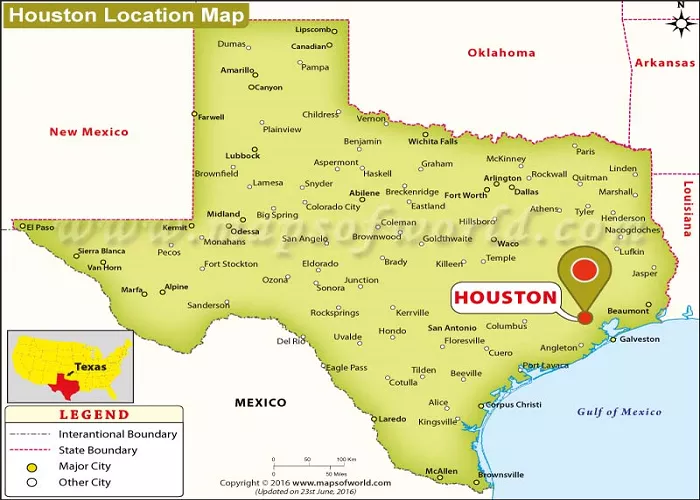Houston is one of the most well-known cities in the United States, but if you’re not familiar with American geography, you might wonder: where exactly is Houston located on the USA map? This article will provide a detailed introduction to Houston’s location, its significance, and its surrounding regions. Whether you’re planning a trip, studying geography, or just curious, this guide will help you understand where Houston fits into the American landscape.
Houston’s Coordinates and Geographic Features
To pinpoint Houston’s exact location, its geographic coordinates are approximately 29.7604° N latitude and 95.3698° W longitude. This places Houston in the southeastern part of Texas, within the Gulf Coastal Plain region.
The city is known for its flat terrain, with an average elevation of just 43 feet (13 meters) above sea level. Houston is also crisscrossed by numerous bayous, which are slow-moving rivers or streams. The most famous of these is Buffalo Bayou, which runs through the heart of the city.
Houston’s Position in Texas
Houston is the largest city in Texas and the fourth-largest city in the United States by population. It is located in Harris County, which is part of the Houston-The Woodlands-Sugar Land metropolitan area. This metro area is one of the most populous in the country, with over 7 million residents.
Here are some key facts about Houston’s location within Texas:
- Distance from Dallas: Approximately 240 miles (386 kilometers) to the northeast.
- Distance from Austin: About 165 miles (266 kilometers) to the west.
- Distance from San Antonio: Roughly 200 miles (322 kilometers) to the southwest.
Houston’s central location within Texas makes it a major transportation and business hub, connecting the state’s eastern and western regions.
Houston’s Climate and Environment
Houston’s location near the Gulf of Mexico significantly influences its climate. The city has a humid subtropical climate, characterized by hot, humid summers and mild winters. Here are some key features of Houston’s climate:
- Summers: Long and hot, with temperatures often exceeding 90°F (32°C).
- Winters: Short and mild, with temperatures rarely dropping below freezing.
- Rainfall: Houston receives abundant rainfall, averaging about 49 inches (124 centimeters) per year.
- Hurricanes: Due to its coastal location, Houston is vulnerable to hurricanes and tropical storms, which can bring heavy rain and flooding.
The city’s environment is also shaped by its proximity to the Gulf of Mexico, with nearby wetlands, forests, and coastal plains contributing to its unique ecosystem.
Houston’s Importance in the USA
Houston is not just a major city in Texas; it is also a key player on the national and global stage. Here are some reasons why Houston is important:
1. Energy Capital of the World
Houston is home to the headquarters of many energy companies, particularly those involved in oil and natural gas. The city’s proximity to the Gulf of Mexico and its extensive port facilities make it a central hub for the energy industry.
2. Space City
Houston is famously known as “Space City” because it is home to NASA’s Johnson Space Center. This is where the Mission Control Center is located, and it has played a crucial role in America’s space exploration efforts, including the Apollo moon missions.
3. Cultural Diversity
Houston is one of the most diverse cities in the United States, with a vibrant mix of cultures, languages, and cuisines. This diversity is reflected in the city’s neighborhoods, festivals, and culinary scene.
4. Economic Powerhouse
Houston has a strong and diverse economy, with major industries including healthcare, manufacturing, aerospace, and transportation. The Port of Houston is one of the busiest ports in the country, facilitating international trade.
Fun Facts About Houston’s Location
- Size: Houston covers an area of about 669 square miles (1,732 square kilometers), making it one of the largest cities in the U.S. by land area.
- Time Zone: Houston is in the Central Time Zone (CT).
- Neighborhoods: The city is divided into several distinct neighborhoods, including Downtown, Midtown, and the Museum District, each with its own unique character.
Conclusion
Houston is a vibrant and dynamic city located in the southeastern part of Texas, near the Gulf of Mexico. Its strategic location has made it a major center for energy, space exploration, and international trade. Whether you’re looking at a map of Texas or the entire United States, Houston stands out as a key city with a rich history and a bright future.
Next time you look at a USA map, you’ll know exactly where to find Houston and why it’s such an important part of the country. From its diverse culture to its economic significance, Houston truly is a city like no other.

